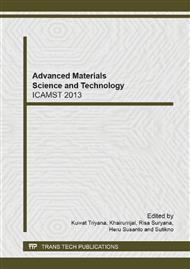[1]
M. Siotto, M. Tosin, F.D. Innocenti, V. Mezzanotte, Mineralization of monomeric components of biodegradable plastics in preconditioned and enriched sandy loam soil under laboratory conditions, Water Air Soil Pollut, 221 (2011) 245–254.
DOI: 10.1007/s11270-011-0787-8
Google Scholar
[2]
S. Arun, K.A. A Kumar, M.S. Sreekala, Fully biodegradable potato starch composites: effect of macro and nano fiber reinforcement on mechanical, thermal and water-sorption characteristics, Int J Plast Technol 16(2012) 50–66.
DOI: 10.1007/s12588-012-9026-4
Google Scholar
[3]
S. Mallakpour, M. Dinari, Synthesis and properties of biodegradable poly(vinyl alcohol)/organo-nanoclay bionanocomposites, J Polym Environ 20 (2012) 732–740.
DOI: 10.1007/s10924-012-0432-7
Google Scholar
[4]
Y. Shinozaki, T. Morita, X.H. Cao, S. Yoshida, M. Koitabashi, T. Watanabe, K. Suzuki, Y.S. Yamashita, T.N. Kambe,T. Fujii, H.K. Kitamoto, Biodegradable plastic-degrading enzyme from Pseudozyma antarctica: cloning, sequencing, and characterization, Appl Microbiol Biotechnol 97 (2013).
DOI: 10.1007/s00253-012-4188-8
Google Scholar
[5]
G.E. Luckachan, C.K.S. Pillai, Biodegradable Polymers- A Review on Recent Trends and Emerging Perspectives, J Polym Environ 199 (2011) 637–676.
DOI: 10.1007/s10924-011-0317-1
Google Scholar
[6]
X. Lu, X. Wen, D. Yang, Isothermal crystallization kinetics and morphology of biodegradable poly(3-hydroxybutyrate-co-4-hydroxybutyrate, J Mater Sci, 46 (2011) 1281–1288.
DOI: 10.1007/s10853-010-4912-7
Google Scholar
[7]
X.S. Wu, Effect of glycerin and starch crosslinking on molecular compatibility of biodegradable poly(lactic acid)-starch composites, J Polym Environ 19 (2011) 912–917.
DOI: 10.1007/s10924-011-0298-0
Google Scholar
[8]
M.M. Reddy, A.K. Mohanty, M. Misra, Optimization of tensile properties thermoplastic blends from soy and biodegradable polyesters: Taguchi design of experiments approach, J Mater Sci 479 (2012) 2591–2599.
DOI: 10.1007/s10853-011-6083-6
Google Scholar
[9]
D. Jagadeesh, D.J.P. Reddy, A.V. Rajulu, Preparations and properties of biodegradable films from wheat protein isolate, J Polym Environ, 19 (2011) 248–253.
DOI: 10.1007/s10924-010-0271-3
Google Scholar
[10]
J.P. Lopez, J. Girones, J.A. Mendez, J. Puig, M.A. Pelach, Recycling ability of biodegradable matrices and their cellulose-reinforced composites in a plastic recycling stream, J Polym Environ 20 (2012) 96–103.
DOI: 10.1007/s10924-011-0333-1
Google Scholar
[11]
M. Conato, F. Sumera, Biodegradable polyesters and polyamides from difunctionalized lauric and coconut fatty acids, J Polym Environ 20 (2012) 217–223.
DOI: 10.1007/s10924-011-0397-y
Google Scholar
[12]
M. Hiskakis, E. Babou, D. Briassoulis, Experimental processing of biodegradable drip irrigation systems—possibilities and limitations, J Polym Environ 19 (2011) 887–907.
DOI: 10.1007/s10924-011-0341-1
Google Scholar
[13]
L. Shi, L. Ao, H. Kang, H. Su, Evaluation of biodegradable films made of waste mycelium and poly (vinyl alcohol) on the yield of pak-choi, J Polym Environ 20 (2012) 492–500.
DOI: 10.1007/s10924-011-0404-3
Google Scholar
[14]
D. Briassoulis, E. Babou, M. Hiskakis, Degradation behaviour and field performance of experimental biodegradable drip irrigation systems, J Polym Environ 19 (2011) 341–361.
DOI: 10.1007/s10924-011-0288-2
Google Scholar
[15]
P.A. Sreekumar, N. Leblanc, J.M. Saiter, Effect of glycerol on the properties of 100 % biodegradable thermoplastic based on wheat flour , J Polym Environ 21 (2013) 388-394.
DOI: 10.1007/s10924-012-0497-3
Google Scholar


